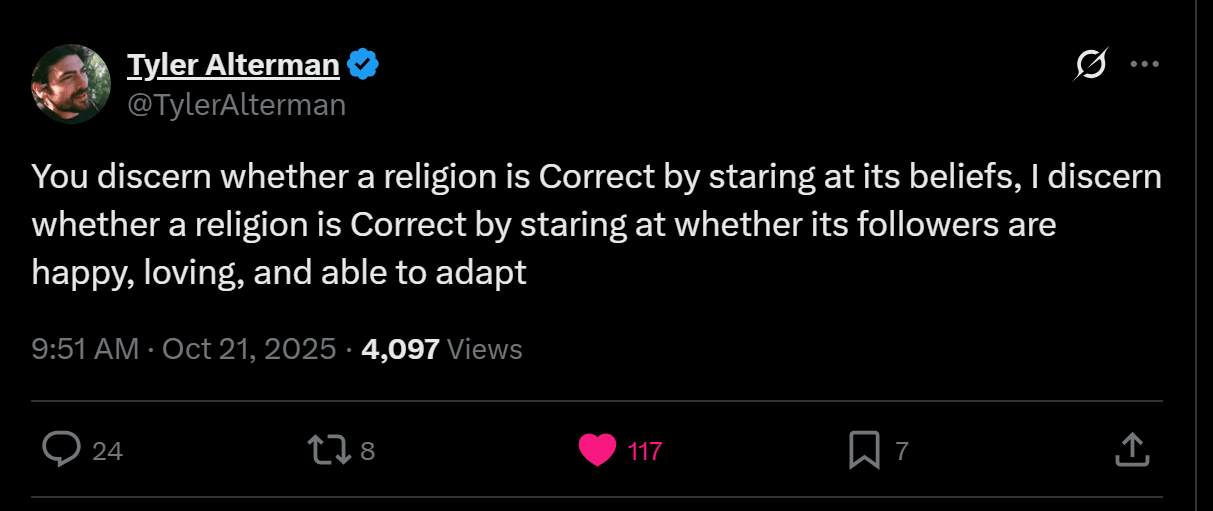Seems like the first two points contradict each other. How can an llm not be good at discovery and also automate human R&D
riffing off of this tweet:

i remember a conversation with a guy who was like 'i think christians are better than buddhists because they tend to be married and have happy children' 'oh, so you think christianity is better because it better upholds christian values?' this is a common issue...
whatever criteria you evaluate a religion on, it reveals your default religion
if you evaluate on beliefs and their correspondence with 'reality', your religion is scientific materialism
if you evaluate on how happy it makes people, your religion is individualistic humanism
there's nothing wrong with simply finding the practices that best instantiate your current religion, but i think there's another way
evaluating religion on whether it can show you things that take you OUTSIDE of your current frame, rather than keeping you inside it
of course, you still run into the fact that you have some criteria - but you're coming from a place where you're actually OPEN to being fundamentally wrong about that religion, and searching for a deeper truth
yes exactly? they think true discernement and the ability to tell what is good right and called for, is a matter of intelligence. thus they think wisdom is intelligence.
That's my point, they think the idea of wisdom is confused and you can replace it with the idea of intelligence or compassion. That there's not a real 'there' there that gives you true discernment and ability to tell what is good, right, called for.
Intelligence is building up, holding on, abstracting. Wisdom is letting go, unwinding, seeing what is. Compassion is the process of trying to build up in order that you or others can let go
I think it is, but compassion is described in a utilitarian way. I'm perhaps using compassion in an unorthodox definition, but actually the way people tend to use it: How do I use intelligence to do good.
This does feel like a nearby fallacy of denying specific examples, which maybe should have its own post
Yes, but this largely because trans man or trans woman doesn't exist within the norm right? I think the terms 'genderqueer' and 'nonbinary' are implicitly about being OUTSIDE the norm, whereas ladyboy is not, it's just another gender category, not a special 'my gender doesn't fit' category.
The dysphoria, the main source of anguish that leads to the desire to transition in the first place, comes from category mismatch between how the world views the individual and how the individual views themselves
I suspect that ladyboy's don't get this, precisely BECAUSE they are accepted in society as something like "man's body but women's gender".
I imagine that it's much HARDER to have this with the way we try to implement 'trans women are women' (compared to the Thai approach) without significant transhumanist tech we don't have yet. Significant aspects of what people see women as are missing from a trans woman's experience, such as being able to bear children (of course, infertile women frequently ALSO get a kind of gender dysphoria from not being able to reproduce, but this is just one of hundreds of little examples).
I see, so the theory is that we are bottleneck Ed on testing old and new ideas, not having the right new ideas